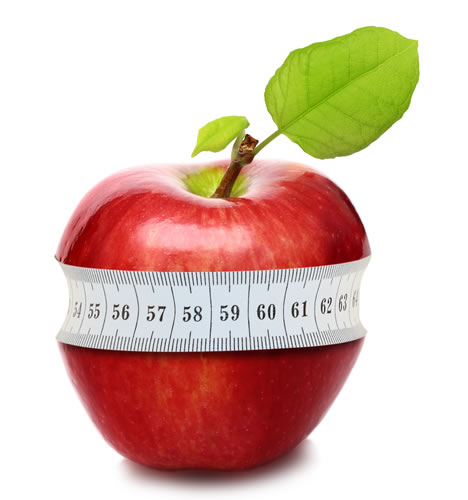We got the following question from a reader: How to lose weight if you have PCOS. I have POCS (polycystic ovary syndrome) and I need to lose 15 pounds in 6 months. It is so hard to lose weight with this condition. What diet should I use and what else can I do?
I assume that by saying you have PCOS you mean polycystic ovary syndrome. I am sure that your doctor will have filled you in about details of the condition. It has some genetic basis but research is unsure to what extent women are born with it. Overweight and obesity have been related with developing the condition as well as family history of type 2 diabetes. Studies support that there is a relationship between developing symptoms of PCOS and insulin resistance.
In very simple terms insulin resistance means that the hormone insulin is less effective in stimulating the body cells. Insulin is involved in the metabolism of sugar in the body, by stimulating the cells to take sugar from the blood and use it for energy or store it among other things. Due to the high risk and the links to diabetes it is quite important to try and keep your blood sugars to a low level and stable (within normal ranges).
You would benefit from reducing your calorie intake, and increase exercise to achieve weight lossand improve insulin sensitivity and sugar metabolism. I would very much suggest following a lower carbohydrate – higher protein –lower fat diet. Below are some of my suggestions:
1. Decrease your calorie intake.
If you find it easier to follow a specific structured diet I would recommend choosing one which is a higher protein – lower carbohydrate diet. Such diets are the zone diet (or 30-40-30), the new Atkins diet and the Dukan diet. I am sure that you will find a plethora of other high protein diets available, however, avoid the ones which tend to cycle calories or carbs (i.e. one day high carbs – one day low carbs or one day high calories – one day low calories cycling). Your aim is to achieve stable and low blood sugar levels which ‘cycling’ or fluctuating calories/carbs diets don’t particularly do.
I find the ‘New high protein diet’ book by Dr Charles Clark and Maureen Clark quite good. It has a number of recipes and lists of foods for meals which you can choose from. If you are not a person to follow an organised diet to the letter the book can be quite useful. This is a suggestion, as there are a number of high protein recipe books which you can pick up from anywhere if you need meal ideas.
2. Avoid the so-called crash diets.
In a general manner whether you do it yourself or follow a specific style diet, what you are aiming for is to have meals which contain protein, small amount of fat and small amount of carbohydrates. Examples of protein are: red meat, chicken, fish, dairy products such as cheese, and eggs.
Examples of carbohydrates are: bread, pasta, potatoes, cakes, sugar and pastries. Choose complex carbohydrates instead of refined carbs i.e. whole meal instead of white bread and pasta. If you look at food labels aim for those with low Gl or GI (glycemic load and glycemic index respectively). If you can try avoid large amounts of bread, pasta etc all together. Opt for legumes which have a lower amount of carbs and for vegetables, salad and fruit instead. If you can’t live without bread etc. as I said opt for wholemeal and have only one slice per meal.
In terms of fat intake, try to lower the amount of fat as well. Best avoid trans fats all together which are found in processed foods, hydrogenated oils such as vegetable oils, crisps, margarine, fried foods etc. Well in general do avoid takeaways, fried foods, fast food and junk food sweets and snacks. I would not suggest going for low fat versions such as low fat version of a cheese.
Opt for cheeses which are lower in fat anyway such as cottage cheese or if you have full fat cheese have a smaller portion. Also avoid fruit yogurts as they may have more sugar, but if you are going to choose between a cake and a fruit yogurt the later is better or add some fruit to plain yogurt and half a spoon of honey even better. Find those combinations that work better for yourself. Do opt for healthier fats such as those found in avocados, oily fish, nuts, olive oils etc. They are beneficial for health.
3. Lower your calorie intake.
Keep a diary of what you eat and drink for a week. This will help you see which foods/drinks you can avoid in your diet and also find calories you are consuming which didn’t think were there. Things such as fizzy drinks and sugary milky coffees and hot drinks contain quite a lot of calories and sugar. Have no sugar in your coffee if you can help it, or have a green tea instead and only one coffee a day.
In average females need 1500 – 2000 Kcal per day. The amount of calories will depend on amount of physical activity and exercise, fitness, build, age etc. In general terms 1200 – 1500 kcal is a safe range for dieting. Don’t go hungry though and don’t over decrease your calorie intake to start off. I understand that it may be difficult to lose weight with PCOS.
Try with a moderate calorie reduction and if you see that it is not working then consult your doctor for the option of going on a very low calorie diet. In some cases a very low calorie diet may be recommended especially if health risks due to weight are present. However, it should be your last option as it can be very hard to follow and can place a lot of stress to your body as well as it may carry some health risks.
4. Be realistic in your weight loss expectations.
You will lose some fat in the first 2 weeks but majority of the weight loss is water, glycogen (stored sugar) and some protein. It does take 2 weeks approximately for the body to adapt to diet and metabolic changes so don’t give up if you don’t see massive results at first. Allow 2-3 weeks and then evaluate your diet.
How much weight have you lost, how do you feel and how difficult is it. If you are used to having a high carbohydrate diet you may experience some craving and mood changes in the first 1-2 weeks. Your body is used to having carbs and it will miss it. Be prepared for it. Find things you can do to distract yourself like a hobby or go for a walk.
Set realistic weight loss goals for each week/month. There is not point setting your weight loss for a stone per month as if you are not going to reach it you will be very disappointed and you may lose your diet momentum. Set it low and if you do lose more, then it is a bonus and you can reward yourself. An average of 0.5 – 1kg per week is within a healthy range for weight loss. However, it does depend on each individual, and also you may find that you may get some good results at first and maybe reach a plateau or straggle at the beginning and then gain momentum. Each person is different.
5. Our bodies burn mainly fat first thing in the morning after an overnight fast, when blood sugar levels are low.
If you can delay having breakfast even for 30min you extend the time by which your body burns fat. Also if you have a protein breakfast it will make you feel full for longer and you will avoid having sugar craving between meals.
6. If you can avoid snacks is the best thing.
However, if you find yourself feeling peckish between meals opt for healthy snacks such as fruit, vegetable sticks or a handful of dried fruit and nut. Dried fruit and nuts are very nutritious but can contain a lot of calories so do keep it to just a handful.
7. Exercise.
It will improve your blood sugar levels, health and increase weight loss. Choose an exercise workout which will suit you. An all over body work out is always better. If you do go to a gym you can get advice from one of the trainers and they should be able to show you an easy and appropriate workout. It doesn’t have to be for hours upon end. As little as 30min a day, 4 times a week should be enough to yield some results. If you can do more exercise the better. If you cannot go to the gym you can try walking, running, cycling, swimming.
You can get some small weight to use at home and do some upper body exercises and some leg, bum and tummy exercises. Is always best to consult an exercise professional to show how to perform exercises correctly as incorrect technique can lead to injuries. A professional can also tell you what your level is as he/she can assess your fitness level.
In terms of increasing fat burning is best to do resistance exercise first (i.e. weights) and aerobic after. An example of a very simple workout can be: 5min warm up mobilising all joints upper and lower body. You could even worm up by hovering the house or tidying up. Start with low weights (i.e. 1kg) do 5x bicep curls for each arm, 30 sec rest, 10 arm circles (no weights) in each direction, 5x each leg prone swimming (from Pilates) and 10 crunches. Then go for a 15min brisk walk; that could be to the shops or around the block. Alternatively if you have stairs go up and down the stairs a couple of times.
This is just an example of a 30min workout. Is always best to consult an exercise professional who can assess your fitness level and ability and also health status (i.e. health questionnaire); this will ensure that the appropriate exercises and at correct level and technique are provided.
Before you follow a diet or exercise regime consult a medical professional especially if there are pre-existing health complaints.
8. Try to increase your sleep.
6 hours is ok but it may not be sufficient to provide rest. Lack of sleep can lead to weight gain or hinder weight loss.
Hope this is off help and if you would like more explanation for any of the points please do contact me.






